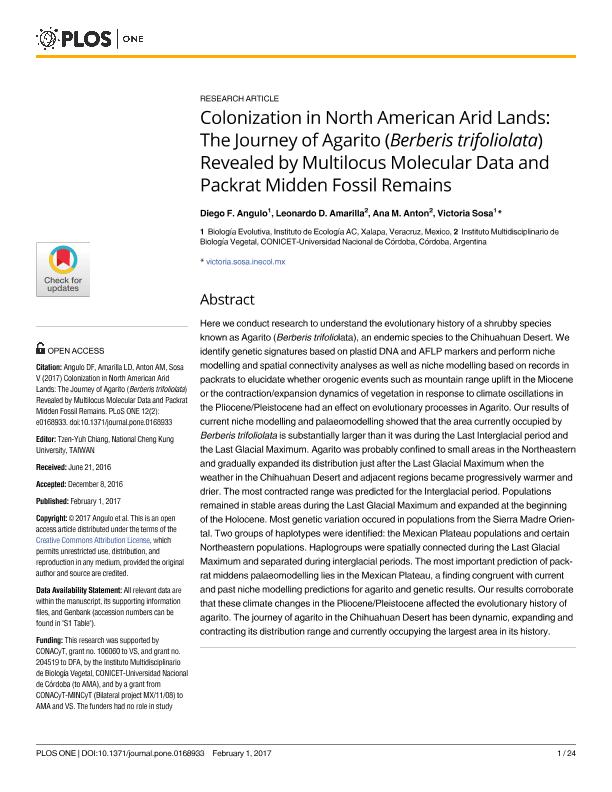Mostrar el registro sencillo del ítem
dc.contributor.author
Angulo, Diego F.

dc.contributor.author
Amarilla, Leonardo

dc.contributor.author
Anton, Ana Maria Ramona

dc.contributor.author
Sosa, Victoria

dc.date.available
2017-09-07T18:38:58Z
dc.date.issued
2017-02
dc.identifier.citation
Angulo, Diego F.; Amarilla, Leonardo; Anton, Ana Maria Ramona; Sosa, Victoria; Colonization in North American Arid Lands: The Journey of Agarito (Berberis trifoliolata) Revealed by Multilocus Molecular Data and Packrat Midden Fossil Remains; Public Library of Science; Plos One; 12; 2; 2-2017; 1-24; e0168933
dc.identifier.issn
1932-6203
dc.identifier.uri
http://hdl.handle.net/11336/23784
dc.description.abstract
Here we conduct research to understand the evolutionary history of a shrubby species known as Agarito (Berberis trifoliolata), an endemic species to the Chihuahuan Desert. We identify genetic signatures based on plastid DNA and AFLP markers and perform niche modelling and spatial connectivity analyses as well as niche modelling based on records in packrats to elucidate whether orogenic events such as mountain range uplift in the Miocene or the contraction/expansion dynamics of vegetation in response to climate oscillations in the Pliocene/Pleistocene had an effect on evolutionary processes in Agarito. Our results of current niche modelling and palaeomodelling showed that the area currently occupied by Berberis trifoliolata is substantially larger than it was during the Last Interglacial period and the Last Glacial Maximum. Agarito was probably confined to small areas in the Northeastern and gradually expanded its distribution just after the Last Glacial Maximum when the weather in the Chihuahuan Desert and adjacent regions became progressively warmer and drier. The most contracted range was predicted for the Interglacial period. Populations remained in stable areas during the Last Glacial Maximum and expanded at the beginning of the Holocene. Most genetic variation occured in populations from the Sierra Madre Oriental. Two groups of haplotypes were identified: the Mexican Plateau populations and certain Northeastern populations. Haplogroups were spatially connected during the Last Glacial Maximum and separated during interglacial periods. The most important prediction of packrat middens palaeomodelling lies in the Mexican Plateau, a finding congruent with current and past niche modelling predictions for agarito and genetic results. Our results corroborate that these climate changes in the Pliocene/Pleistocene affected the evolutionary history of agarito. The journey of agarito in the Chihuahuan Desert has been dynamic, expanding and contracting its distribution range and currently occupying the largest area in its history.
dc.format
application/pdf
dc.language.iso
eng
dc.publisher
Public Library of Science

dc.rights
info:eu-repo/semantics/openAccess
dc.rights.uri
https://creativecommons.org/licenses/by/2.5/ar/
dc.subject
Phylogeography
dc.subject
Dererts
dc.subject
Paleoclimatology
dc.subject
Haplotypes
dc.subject.classification
Bioquímica y Biología Molecular

dc.subject.classification
Ciencias Biológicas

dc.subject.classification
CIENCIAS NATURALES Y EXACTAS

dc.subject.classification
Bioquímica y Biología Molecular

dc.subject.classification
Ciencias Biológicas

dc.subject.classification
CIENCIAS NATURALES Y EXACTAS

dc.title
Colonization in North American Arid Lands: The Journey of Agarito (Berberis trifoliolata) Revealed by Multilocus Molecular Data and Packrat Midden Fossil Remains
dc.type
info:eu-repo/semantics/article
dc.type
info:ar-repo/semantics/artículo
dc.type
info:eu-repo/semantics/publishedVersion
dc.date.updated
2017-09-07T16:51:58Z
dc.journal.volume
12
dc.journal.number
2
dc.journal.pagination
1-24; e0168933
dc.journal.pais
Estados Unidos

dc.journal.ciudad
San Francisco
dc.description.fil
Fil: Angulo, Diego F.. Consejo Nacional de Ciencia y Tecnología. Instituto de Ecología; México
dc.description.fil
Fil: Amarilla, Leonardo. Consejo Nacional de Investigaciones Científicas y Técnicas. Centro Científico Tecnológico Conicet - Córdoba. Instituto Multidisciplinario de Biología Vegetal. Universidad Nacional de Córdoba. Facultad de Ciencias Exactas Físicas y Naturales. Instituto Multidisciplinario de Biología Vegetal; Argentina
dc.description.fil
Fil: Anton, Ana Maria Ramona. Consejo Nacional de Investigaciones Científicas y Técnicas. Centro Científico Tecnológico Conicet - Córdoba. Instituto Multidisciplinario de Biología Vegetal. Universidad Nacional de Córdoba. Facultad de Ciencias Exactas Físicas y Naturales. Instituto Multidisciplinario de Biología Vegetal; Argentina
dc.description.fil
Fil: Sosa, Victoria. Consejo Nacional de Ciencia y Tecnología. Instituto de Ecología; México
dc.journal.title
Plos One

dc.relation.alternativeid
info:eu-repo/semantics/altIdentifier/doi/http://dx.doi.org/10.1371/journal.pone.0168933
dc.relation.alternativeid
info:eu-repo/semantics/altIdentifier/urn/http://journals.plos.org/plosone/article?id=10.1371/journal.pone.0168933
Archivos asociados
